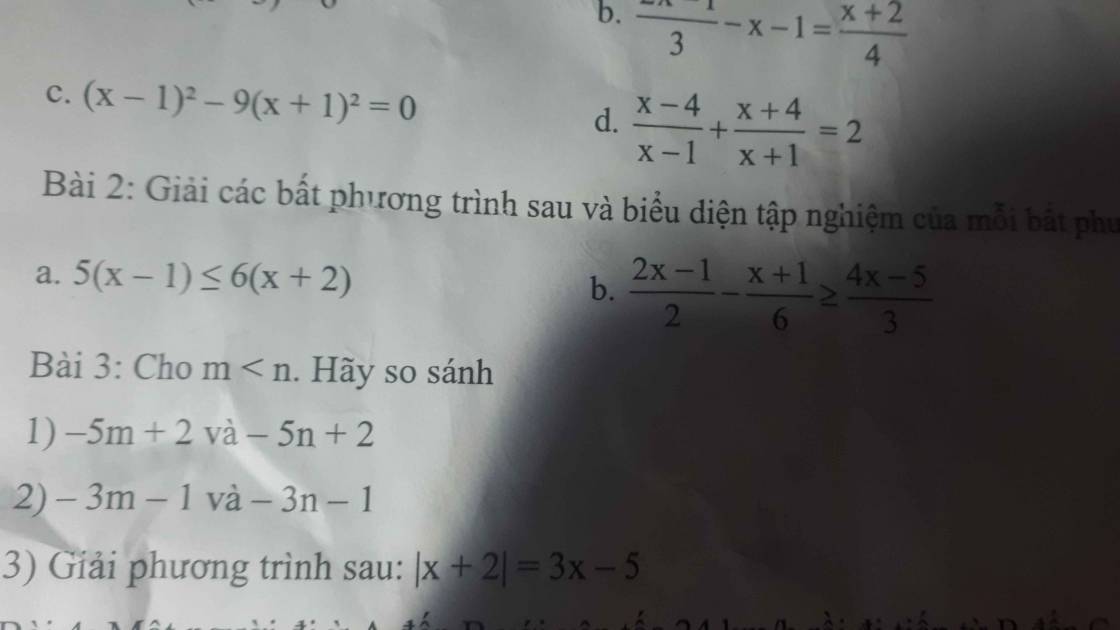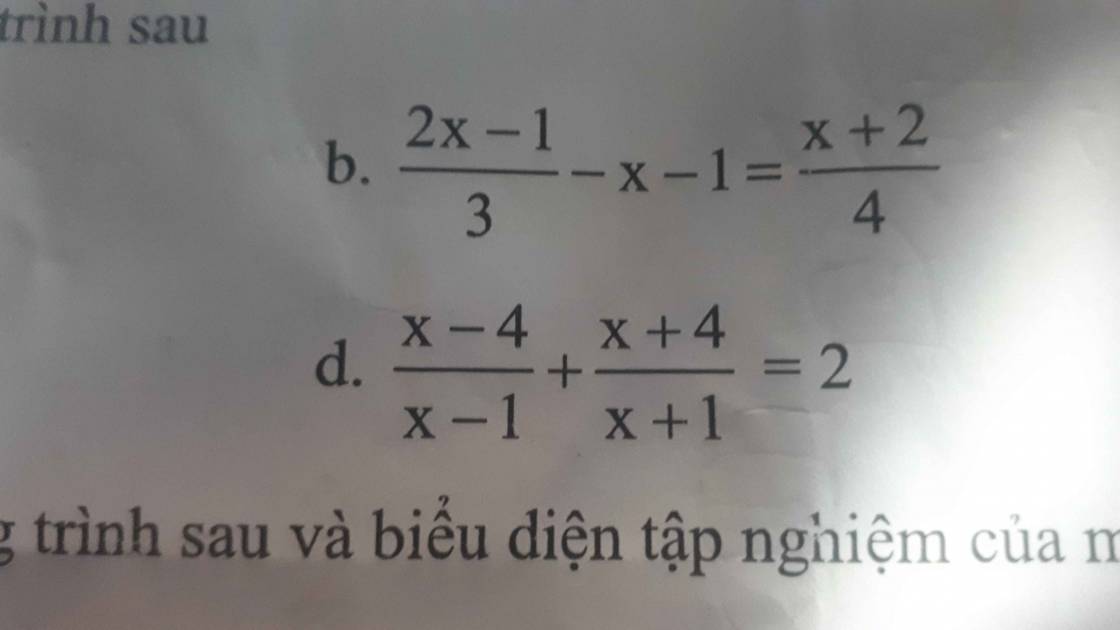Cho \(\Delta ABC\) cân tại A. Trên tia đối của tia BC lấy điểm M, trên tia đối của tia BC lấy điểm N sao cho BM=CN. Từ B và C lần lượt hạ BH\(\perp AM\), Ck\(\perp AN\) . Tìm các cặp tam giác bằng nhau ae vẽ cả hình cho mik
Hãy nhập câu hỏi của bạn vào đây, nếu là tài khoản VIP, bạn sẽ được ưu tiên trả lời.


Bài 2:
a) \(5\left(x-1\right)\le6\left(x+2\right)\)
\(\Leftrightarrow5x-5\le6x+12\)
\(\Rightarrow x\ge-17\)
b) \(\dfrac{2x-1}{2}-\dfrac{x+1}{6}\ge\dfrac{4x-5}{3}\)
\(\Leftrightarrow\dfrac{3\left(2x-1\right)-\left(x+1\right)}{6}\ge\dfrac{2\left(4x-5\right)}{6}\)
\(\Rightarrow6x-3-x-1\ge8x-10\)
\(\Leftrightarrow3x\le6\)
\(\Rightarrow x\le2\)
...

\(\dfrac{x-4}{x-1}+\dfrac{x+4}{x+1}=2\)
ĐKXĐ: \(x\ne\pm1\)
\(\Leftrightarrow\dfrac{\left(x-4\right)\left(x+1\right)}{\left(x-1\right)\left(x+1\right)}+\dfrac{\left(x+4\right)\left(x-1\right)}{\left(x-1\right)\left(x+1\right)}=\dfrac{2\left(x-1\right)\left(x+1\right)}{\left(x-1\right)\left(x+1\right)}\)
\(\Rightarrow x^2-3x-4+x^2+3x-4=2\left(x^2-1\right)\)
\(\Leftrightarrow2x^2-8-2x^2+2=0\)
\(\Leftrightarrow-6=0\) (Vô lí)
Vậy phương trình trên vô nghiệm.

(4x2 + 8xy - 3xy2 )(-\(\dfrac{3}{4}\)x2y)
= -3x2y - 6x3y2 +\(\dfrac{9}{4}\)x3y3
4x3(2x2 - x + 5) 5x
= 20x4(2x2 - x + 5)
= 40x6 - 20x5 +100x4

\(\left(x-1\right)^2-9\left(x+1\right)^2=0\)
\(\Leftrightarrow x^2-2x+1-9\left(x^2+2x+1\right)=0\)
\(\Leftrightarrow x^2-2x+1-9x^2-2x-9=0\)
\(\Leftrightarrow-8x^2-4x-8=0\)
\(\Leftrightarrow-4\left(2x^2+x+2\right)=0\)
\(\Leftrightarrow2x^2+x+2=0\)
Xét \(\Delta=1^2-4\cdot2\cdot2=-15< 0\)
⇒ Phương trình vô nghiệm
Vậy \(S=\varnothing\).
(x-1)2 - 9 (x-1)2 = 0
(x-1)2.(1-9) =0
x-1 = 0
x = 1

Ta có: \(\left(x-1\right)^2-9\left(x+1\right)^2=0\)
\(\Leftrightarrow\left[\left(x-1\right)-3\left(x+1\right)\right]\left[x-1+3\left(x+1\right)\right]=0\)
\(\Leftrightarrow\left(-2x-4\right)\left(4x+2\right)=0\)
\(\Leftrightarrow\left[{}\begin{matrix}-2x-4=0\\4x+2=0\end{matrix}\right.\Leftrightarrow\left[{}\begin{matrix}x=-2\\x=-\dfrac{1}{2}\end{matrix}\right.\)
...

I'll let you draw the figure.
a) AM is a median of the triangle ABC. Therefore, M is the midpoint of BC.
E is symmetric to A through M, so M is the midpoint of AE.
Consider the quadrilateral ABEC, it has M is the midpoint of both AE and BC. Thus, ABEC is a parallelogram.
b) Consider the triangle ADE, M is the midpoint of AE, H is the midpoint of AD. Therefore, HM is the average line of this triangle. This means \(HM//DE\) or \(DE//BC\), which means BCED is a trapezoid.
Triangle ABD has the height BH, which is also a median. Thus, ABD must be an isosceles triangle, which means the height BH is also a bisector, or \(\widehat{ABH}=\widehat{DBH}\) or \(\widehat{ABC}=\widehat{DBC}\)
On the other hand, ABEC is a parallelogram. So, \(AB//CE\) and this leads to \(\widehat{ABC}=\widehat{ECB}\) (2 staggered angles of 2 parallel lines)
From these, we have \(\widehat{DBC}=\widehat{ECB}\left(=\widehat{ABC}\right)\)
The trapezoid BCED (DE//BC) has \(\widehat{DBC}=\widehat{ECB}\). Therefore, BCED must be an isosceles trapezoid.


5. (2 + x) (x+2) - \(\dfrac{1}{2}\) . (6-8x)2 + 17
= 5 ( x2 + 4x + 4) - \(\dfrac{1}{2}\). 4 ( 3 - 4x) 2+ 17
= 5x2 + 20 x + 20 - 2 ( 9 - 24x + 16x2) + 17
= 5x2 + 20x + 20 - 18 + 58x - 32x2 + 17
= -27x2 + 78 x + 19

